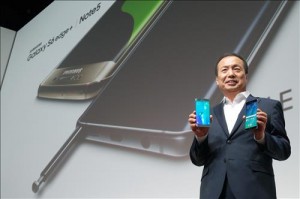- California Assembly OKs highest minimum wage in nation
- S. Korea unveils first graphic cigarette warnings
- US joins with South Korea, Japan in bid to deter North Korea
- LPGA golfer Chun In-gee finally back in action
- S. Korea won’t be top seed in final World Cup qualification round
- US men’s soccer misses 2nd straight Olympics
- US back on track in qualifying with 4-0 win over Guatemala
- High-intensity workout injuries spawn cottage industry
- CDC expands range of Zika mosquitoes into parts of Northeast
- Who knew? ‘The Walking Dead’ is helping families connect
Samsung unveils two new phablets

Shin Jong-kyun, the head of Samsung Electronics’ mobile division, holds the Galaxy S6+ (L) and the Galaxy Note 5 (R) on Aug. 13, 2015 in New York. (Yonhap)
SEOUL/NEW YORK (Yonhap) — South Korea’s top tech giant Samsung Electronics Co. showcased two new phablets on Thursday in the United States, with one being the larger edition of the Galaxy S6 Edge, which curves on both sides.
Dubbed the Galaxy Note 5 and the Galaxy S6 Edge+, the phablets, a combination of smartphone and tablet PC, were showcased at Lincoln Center in New York. The official sales will begin around the world later this month.
As expected, the Galaxy Note 5 and the Galaxy S6 Edge+ both come with a super active mode organic light-emitting diode (SAMOLED) QHD 5.7-inch display, boasting the same display size as the Galaxy Note 4.
They also boast two high-performance cameras — one 16 megapixels, the other 5 megapixels — along with a 64-bit octa-core processor and 4GB RAM. There are four colors available: white, black, gold, and silver.
The Galaxy Note 5, although it comes with a lower-than-expected battery capacity of 3,000 mAh, is capable of being fully charged in around 90 minutes. The wireless charging system also completes such a process in 120 minutes. The Galaxy Note 4 held a battery of 3,220mAh.
There will be two editions of the two phablets, each boasting a 32GB and 64GB data storage capacity, respectively.
Other features of the Galaxy Note 5 include the fifth-generation S Pen with an improved Air Command function as well as built-in applications, including Microsoft Corp.’s flagship office programs.
The Galaxy Note 5 is significant in that its thickness stands at 7.6 mm, slimmer than its predecessor’s 8.5 mm. Samsung said users can take the pen out simply by pressing it lightly. The Galaxy S6+ Edge’s thickness stands at 6.9 mm, compared to the Galaxy S6 Edge’s 7.0 mm.
Users can take notes on their devices even when the display is off, allowing them to save “ideas that just suddenly come to mind,” the company added.
Users are also allowed to live stream videos through YouTube, a popular video-sharing website.
Samsung has improved the phablets’ connectivity with other smart devices, allowing them to receive messages and other alerts through tablet PCs or laptops.
With the Galaxy Note 5 and the Galaxy S6 Edge Plus both supporting Samsung’s own mobile payment service, the release of the two devices will rise as threats to the Apple Pay service powered by iPhones.
The Samsung Pay service, which is currently on a pilot run after the release of the Galaxy S6, supports not only the near field communication (NFC) technology, but also magnetic secure transmission (MST) and bar code technologies.
The MST technology is significant as it is compatible with conventional credit card devices, meaning it can be used in a larger number of shops compared with Apple Pay.
While the South Korean giant has introduced new phablets at Germany’s Internationale Funkausstellung (IFA), which falls in September, market watchers said the earlier-than-usual release occurred as Apple is set to showcase the iPhone 6S and the iPhone 6S Plus next month.
Samsung has been facing hurdles in its mobile business, with its earnings being dented by the rise of Chinese firms and Apple’s iPhone devices.
Samsung Electronics said earlier the operating profit of the information technology and mobile business division, one of the company’s main revenue sources, fell 37.5 percent on-year to 2.76 trillion won (US$2.34 billion) in the second quarter.
The company said handset sales lost 6.3 percent on-year in the second quarter to 89 million units, indicating that the Galaxy S6 series, which was kicked off in April, posted weak sales.















